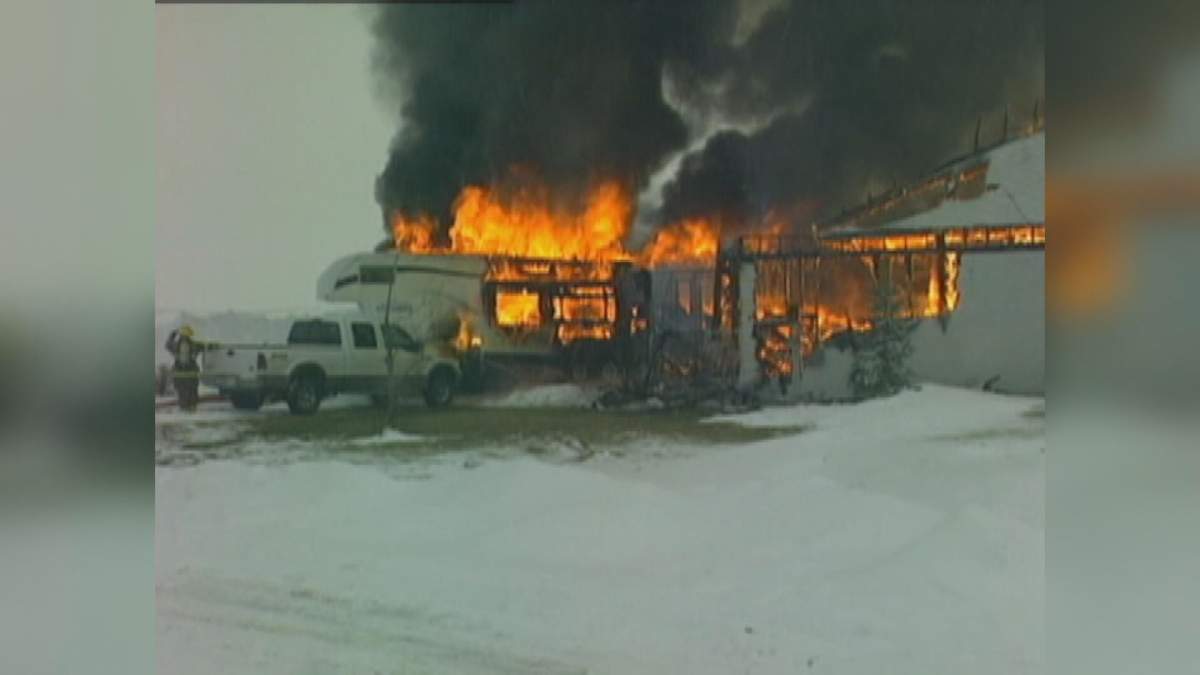Ten years ago, Todd McKay and his son were getting set to watch the Grey Cup when their fire alarm went off.

“In the living room, the smoke was billowing out of the wall from the garage,” McKay said. “I said, ‘Grab the dog,’ and we left… and watched our house burn to the ground.”
Within a half-hour McKay’s Lethbridge-area house was engulfed in flames and destroyed by fire.
Nobody was hurt but the family had lost everything.
It was that loss that encouraged McKay, who worked in home building and construction, to look at building homes differently.
“You put the most valuable people, precious items to you, and then you put them in a house that gives them seven minutes to escape,” McKay said.
“I decided we have to find a better way to build.”
McKay founded MgO Systems, a building materials company based in Calgary.

Get daily National news
MgO uses magnesium oxide as part of its cement mixture to create panels that can be used in residential and commercial constriction as a replacement for conventional materials like drywall.
The panels are fire resistant, mould-resistant, durable and environmentally friendly as they don’t produce off-gas.
According to McKay, there are many ancient structures like the Great Wall of China and the Roman aquaducts built with cement with the magnesium oxide additive, but the practice is seldom used outside of Russia, China and North Korea.
“We now have a wall system, an insulation system, a board product that’s green, environmentally friendly, zero off-gas, won’t burn, won’t mould, won’t contaminate, and it costs relatively the same dollar value,” McKay said. “Why wouldn’t we use it?”
MgO has been ordering the magnesium oxide boards from China, but is now creating its own boards with magnesium mined in Radium, B.C., and processed near Exshaw, west of Calgary.
To help with the boards’ durability, MgO has been researching the use of recycled plastic fibres from items like PVC pipes.
“Not only can we take these waste products away from landfills, but they actually improve the performance metrics of our composite materials,” MgO’s vice-president of research and product development, Doug Brown, said. “We know that there is a massive eco-consequence of us using plastics.”
Their work using plastics has earned them a $1-million grant from the federal government.
The company was one of three to receive a grant from Environment and Climate Change Canada as part of its Plastics Innovation Challenge aimed at supporting Canadian businesses with innovative ideas to reduce plastic pollution from food packaging and construction.
The other winners include Montreal-based Axiplymer Inc., which created a recyclable multi-layer film that can be used for food packaging, as well as Brantford, Ont.-based GreenMantra Technologies, which transformed polystyrene insulation waste into new insulation.
The federal government said that plastic pollution is posing a threat to the Canadian economy, with much of the plastic ending up in landfills, parks, beaches and bodies of water.
It’s an issue the federal government hopes to address through investments in clean technology.
“Boosting clean technology development to address plastic pollution is part of our comprehensive approach to achieve a zero plastic waste future,” Environment and Climate Change Minister Jonathan Wilkinson said in a press release.
“The Government of Canada has committed nearly $19 million to fund Canadian innovators through the Canadian Plastics Innovation Challenge initiative, which results in real, Canadian-made solutions.”
According to MgO, the grant funding allows for more research and development of the magnesium boards, and accelerates the process to sell them commercially.
The boards cost more than conventional drywall materials, but MgO said the benefits far outweigh the costs.
“Finding those early adopters of our technology will be critical in convincing them that there is not only a higher performance metrics in your building that we can offer, but it’s worth that added extra cost for them to make that choice,” Brown said.
It’s a made-in-Alberta solution that McKay hopes will transform how homes are built, and hopefully prevent a tragedy.
“How many times a month do you read another article or see another news story about a family dying in a house fire?” McKay said. “We can stop that. We need to make a difference.”




Comments